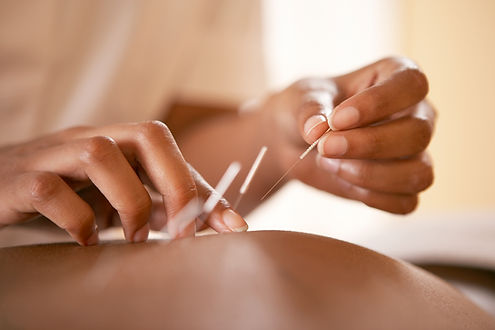
ACUPUNCTURE
Treatment for Mind, Body, and Spirit
What to Expect
Each person who performs acupuncture has a unique style, often blending aspects of Eastern and Western approaches to medicine. To determine the type of acupuncture treatment that will help you the most, your practitioner may ask you about your symptoms, behaviors and lifestyle. He or she may also closely examine:
-
The parts of your body that are painful
-
The shape, coating and color of your tongue
-
The color of your face
-
The strength, rhythm and quality of the pulse in your wrist
This initial evaluation may take up to 60 minutes. Subsequent appointments usually take about a half-hour. A common treatment plan for a single complaint would typically involve one or two treatments a week. Number of treatments will depend on the condition being treated and its severity, but six to eight treatments are common.
During acupuncture
Acupuncture points are situated in all areas of the body. Sometimes the appropriate points are far removed from the area of your pain. Your acupuncture practitioner will tell you the general site of the planned treatment and if you need to remove any clothing. If appropriate, a gown, towel or sheet will be provided to preserve your modesty. You lie on a padded table for the treatment, which involves:
-
Needle insertion. Acupuncture needles are very thin, so insertion usually causes little discomfort. Between five and 20 needles are used in a typical treatment. You may feel a mild aching sensation when a needle reaches the correct depth.
-
Needle manipulation. Your practitioner may gently move or twirl the needles after placement or apply heat or mild electrical pulses to the needles.
-
Needle removal. In most cases, the needles remain in place for 10 to 20 minutes while you lie still and relax. There is usually no discomfort when the needles are removed.
Conditions Treated
In an official report, Acupuncture: Review and Analysis of Reports on Controlled Clinical Trials, the WHO (WHO) has listed the following symptoms, diseases and conditions that have been shown through controlled trials to be treated effectively by acupuncture:
low back pain
neck pain
sciatica
tennis elbow
knee pain
periarthritis of the shoulder
sprains
facial pain (including craniomandibular disorders)
headache
dental pain
tempromandibular (TMJ) dysfunction
rheumatoid arthritis
induction of labor
correction of malposition of fetus (breech presentation)
morning sickness
nausea and vomiting
postoperative pain
stroke
essential hypertension
primary hypotension
renal colic
leucopenia
adverse reactions to radiation or chemotherapy
allergic rhinitis, including hay fever
biliary colic
depression (including depressive neurosis and depression following stroke)
acute bacillary dysentery
primary dysmenorrhea
acute epigastralgia
peptic ulcer
acute and chronic gastritis
Acupuncture Aftercare
Most people find acupuncture relaxing and often feel very calm after a treatment. You may feel a little tired or sleepy and should take this into account if you are planning to drive or use heavy machinery straight after your treatment.
You should refrain from vigorous exercise after treatment and, ideally, give yourself a little time to rest. It is also advisable not to drink alcohol for several hours after treatment.
Acupuncture has very few side effects and any that do occur are usually mild and self-correcting.

